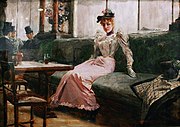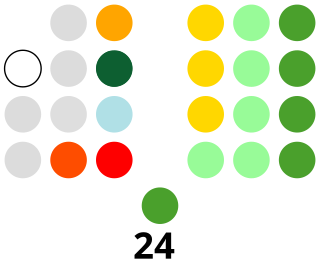
The Congress of the Philippines is the legislature of the national government of the Philippines. It is bicameral, composed of a lower body, the House of Representatives, although colloquially the term "Congress" commonly refers to just the latter, and an upper body, the Senate. The House of Representatives meets in the Batasang Pambansa in Quezon City while the Senate meets in the GSIS Building in Pasay.

The Senate of the Philippines is the upper house of Congress, the bicameral legislature of the Philippines with the House of Representatives as the lower house. The Senate is composed of 24 senators who are elected at-large under plurality-at-large voting.

Juan Luna de San Pedro y Novicio Ancheta was a Filipino painter, sculptor and a political activist of the Philippine Revolution during the late 19th century. He became one of the first recognized Philippine artists.

Luna, officially the Municipality of Luna, is a 3rd class municipality in the province of La Union, Philippines. According to the 2020 census, it has a population of 37,318 people.
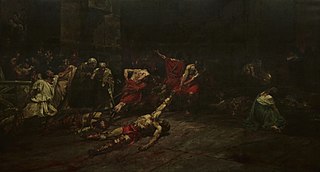
The Spoliarium is a painting by Filipino painter Juan Luna. Luna, working on canvas, spent eight months completing the painting which depicts dying gladiators. The painting was submitted by Luna to the Exposición Nacional de Bellas Artes in 1884 in Madrid, where it garnered the first gold medal. The picture recreates a despoiling scene in a Roman circus where dead gladiators are stripped of weapons and garments. Together with other works of the Spanish Academy, the Spoliarium was on exhibit in Rome in April 1884.

Epifanio de los Santos y Cristóbal, also known as Don Pañong or Don Panyong, was a notable Filipino historian, journalist, and civil servant. He was regarded as one of the best Filipino writers and a literary genius. He also entered politics, serving as a member of the Malolos Congress from 1898 to 1899 from Nueva Ecija and later as governor of Nueva Ecija from 1902 to 1906. As a lawyer, he was named as the district attorney of San Isidro, Nueva Ecija in 1900 and later as fiscal of the provinces of Bulacan and Bataan. He was named as an assistant technical director of the Philippine Census in 1918. He was appointed Director of the Philippine Library and Museum by Governor General Leonard Wood in 1925, serving until his death in 1928.
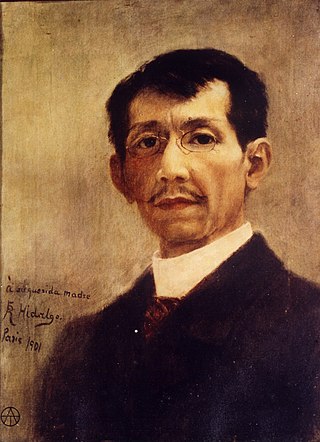
Félix Resurrección Hidalgo y Padilla was a Filipino artist. He is acknowledged as one of the greatest Filipino painters of the late 19th century, and is significant in Philippine history for having been an acquaintance and inspiration for members of the Philippine reform movement which included José Rizal, Marcelo del Pilar, Mariano Ponce, and Graciano López Jaena, although he neither involved himself directly in that movement, nor later associated himself with the First Philippine Republic under Emilio Aguinaldo.

Vicente Silva Manansala was a Filipino cubist painter and illustrator. One of the first Abstractionists on the Philippine art scene Vicente Manansala is also credited with bridging the gap between the city and the suburbs, between the rural and cosmopolitan ways of life. His paintings depict a nation in transition, an allusion to the new culture brought by the Americans. Manansala together with Fabian de la Rosa are among the best-selling Philippine artists in the West.

The Parish of the Holy Sacrifice, also known as the Church of the Holy Sacrifice, is a landmark Roman Catholic chapel on the University of the Philippines Diliman campus. It belongs to the Roman Catholic Diocese of Cubao and its present parish priest is Rev. Fr. Jose S. Tupino III. More popularly known as the UP Chapel, the church was constructed under the supervision of Fr. John P. Delaney, who began ministering to the spiritual needs of the campus in 1947.

The Manila North Cemetery is one of the oldest cemeteries in Metro Manila, Philippines. The cemetery is owned by and located in the City of Manila, the national capital, and is one of the largest in the metropolis at 54 hectares. It is located alongside Andrés Bonifacio Avenue and borders two other important cemeteries: the La Loma Cemetery and the Manila Chinese Cemetery. Numerous impoverished families notably inhabit some of the mausoleums.
España y Filipinas is a series of oil on wood paintings by Filipino painter, Ilustrado, and revolutionary activist, Juan Luna. It is an allegorical depiction of two women together, one a representation of Spain and the other of the Philippines. The painting, also known as España llevando a la gloria a Filipinas or España Guiando a Filipinas, is regarded as one of the “enduring pieces of legacy” that the Filipinos inherited from Luna.

The Blood Compact is an 1886 historical painting by the Filipino painter Juan Luna. It was a gift to the Manila city council.

La Bulaqueña, literally "the woman from Bulacan" or "the Bulacan woman", also sometimes referred to as Una Bulaqueña, is the Spanish title of an 1895 painting by Filipino painter and revolutionary activist Juan Novicio Luna. Bulacan is a province in the Philippines in Luzon island and its residents are called Bulaqueños, also spelled as Bulakenyos in the Filipino language. It is a "serene portrait", of a Filipino woman wearing a María Clara gown, a traditional Filipino dress that is composed of four pieces, namely the camisa, the saya, the pañuelo, and the tapis. The name of the dress is an eponym to María Clara, the mestiza heroine of Filipino hero José Rizal's novel Noli Me Tangere. The woman's clothing in the painting is the reason why the masterpiece is alternately referred to as María Clara. It is one of the few canvases done by Luna illustrating Filipino culture. The painting is displayed at the National Museum of Fine Arts.

Las Virgenes Cristianas Expuestas al Populacho or The Christian Virgins Exposed to the Populace is a famous 1884 history painting by Filipino painter, reformist, and propagandist Félix Resurrección Hidalgo. The painting is alternately known as The Christian Virgins Exposed to the Rabble, Jovenes Cristianas Expuestas al Populacho, Christian Virgins Presented to the Populace, The Christian Virgins Being Exposed to the Populace, and Christian Virgins Exposed to the Mob.

The Battle of Lepanto is a painting by Filipino painter and revolutionary activist Juan Luna. Along with Félix Resurrección Hidalgo, Luna is one of the first Filipinos to excel and earn recognition in the international field of arts and culture.

Ancestral houses of the Philippines or Heritage Houses are homes owned and preserved by the same family for several generations as part of the Filipino family culture. It corresponds to long tradition by Filipino people of giving reverence for ancestors and elders. Houses could be a simple house to a mansion. The most common ones are the "Bahay na Bato". Some houses of prominent families had become points of interest or museums in their community because of its cultural, architectural or historical significance. These houses that are deemed of significant importance to the Filipino culture are declared Heritage House by the National Historical Commission of the Philippines (NHCP), previously known as the National Historical Institute (NHI) of the Philippines. Preservation is of utmost importance as some ancestral houses have come into danger due to business people who buy old houses in the provinces, dismantle them then sell the parts as ancestral building materials for homeowners wishing to have the ancestral ambiance on their houses. These ancestral houses provide the current generation a look back of the country's colonial past through these old houses.

The Tanghalang Pambansa, formerly Theater of Performing Arts, is a theater located in the Cultural Center of the Philippines Complex in Manila, Philippines.
Philippines National Historic Landmarks is a registry of historic sites in the Philippines that have been officially declared by the Philippine Registry of Cultural Property.
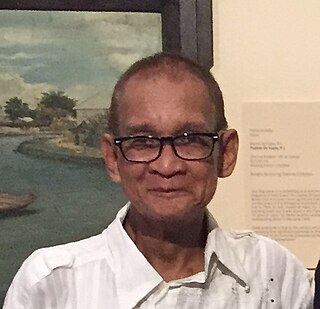
Santiago Albano Pilar more popularly known as Jak Pilar, was a Filipino art historian, curator, and author. He was best known for chronicling Philippine art centered on the 19th and the 20th century in numerous publications in both the Philippines and overseas.
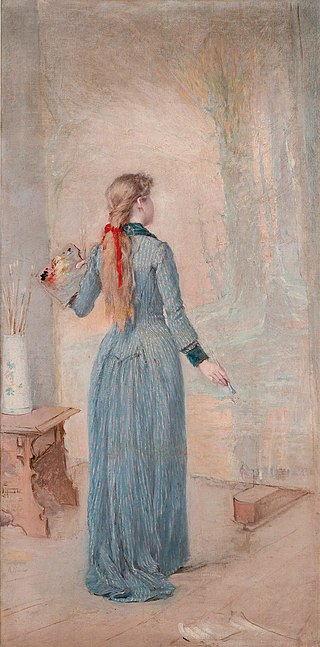
The La Pintura is a painting by the Filipino artist Félix Resurrección Hidalgo done in the style of Impressionism. The painting depicts a woman holding an paintbrush while turning back to the viewer, as she gazes towards an unfinished canvas. Hidalgo's La Pintura was subsequently sold for a world record of the artist of PHP78.256 million at a Salcedo Auctions' Important Philippine Art sale in the Philippines on September 21, 2019.













